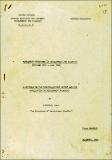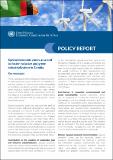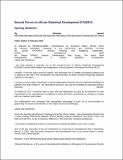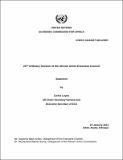Our Institutional Repository is currently undergoing an upgrade. The platform remains accessible for search and consultation. However, user login and content submissions are temporarily disabled. We appreciate your understanding.
A critique of the capital output ratio and its application to development planning
| dc.description.abstract | There is one type of model that dominates the literature and the plans. This is the Harrod-Domar model and its numerous variations. In this, the strategic variables that are selected are aggregates such as employment, investment and output. But instead of the neo-classical assumption of perfect substitutability of capital for labour, the starting point is the assumption of fixed technical or behavioural coefficients, so that aggregate output is related to the stock of capital by the capital/output ratio, otherwise known as the capital coefficient. This is the salient feature added by the Harrod-Domar model to the Keynesian short-period theory of employment. The crucial role, in economic theory and planning, of the ‘capital/output ratio’ is well brought out in an article by an Indian writer: If there is one concept that has dominated recent discussions on growth theory and development planning, it is that of the capital-output ratio, or the capital-coefficient as it is sometimes called. It has been extensively used in various growth models, e.g., those of Harrod, Domar, Kaldor, and Mahalanobis, and it has also helped the formulation of our First and Second Five Year Plans.2 | en |
| dc.title | A critique of the capital output ratio and its application to development planning | en |
| uneca.subject.fulltaxonomy | UNBIS::ECONOMIC DEVELOPMENT AND DEVELOPMENT FINANCE::DEVELOPMENT | en |
| uneca.subject.fulltaxonomy | UNBIS::ECONOMIC DEVELOPMENT AND DEVELOPMENT FINANCE::DEVELOPMENT | en |
| uneca.subject.fulltaxonomy | UNBIS::ECONOMIC DEVELOPMENT AND DEVELOPMENT FINANCE::DEVELOPMENT | en |
| uneca.subject.fulltaxonomy | UNBIS::ECONOMIC DEVELOPMENT AND DEVELOPMENT FINANCE::DEVELOPMENT::DEVELOPMENT PLANNING | en |
| uneca.subject.fulltaxonomy | UNBIS::ECONOMIC DEVELOPMENT AND DEVELOPMENT FINANCE::DEVELOPMENT::DEVELOPMENT PLANNING | en |
| uneca.subject.fulltaxonomy | UNBIS::ECONOMIC DEVELOPMENT AND DEVELOPMENT FINANCE::DEVELOPMENT::DEVELOPMENT PLANNING | en |
| uneca.subject.fulltaxonomy | UNBIS::ECONOMIC DEVELOPMENT AND DEVELOPMENT FINANCE::DEVELOPMENT::DEVELOPMENT STRATEGIES | en |
| uneca.subject.fulltaxonomy | UNBIS::ECONOMIC DEVELOPMENT AND DEVELOPMENT FINANCE::DEVELOPMENT::DEVELOPMENT STRATEGIES | en |
| uneca.subject.fulltaxonomy | UNBIS::ECONOMIC DEVELOPMENT AND DEVELOPMENT FINANCE::DEVELOPMENT::DEVELOPMENT STRATEGIES | en |
| uneca.subject.fulltaxonomy | UNBIS::ECONOMIC DEVELOPMENT AND DEVELOPMENT FINANCE::DEVELOPMENT::REGIONAL PLANNING | en |
| uneca.subject.fulltaxonomy | UNBIS::ECONOMIC DEVELOPMENT AND DEVELOPMENT FINANCE::DEVELOPMENT::REGIONAL PLANNING | en |
| uneca.subject.fulltaxonomy | UNBIS::ECONOMIC DEVELOPMENT AND DEVELOPMENT FINANCE::DEVELOPMENT::REGIONAL PLANNING | en |
| uneca.subject.fulltaxonomy | UNBIS::GEOGRAPHICAL DESCRIPTORS::AFRICA::SENEGAL | en |
| uneca.subject.fulltaxonomy | UNBIS::GEOGRAPHICAL DESCRIPTORS::AFRICA::SENEGAL | en |
| uneca.subject.fulltaxonomy | UNBIS::GEOGRAPHICAL DESCRIPTORS::AFRICA::SENEGAL | en |
| uneca.creatorCorporate.fulltaxonomy | Corporate Authors::United Nations. Economic Commission for Africa. African Institute for Economic Development and Planning(IDEP) | en |
| ags.creatorCorporate | United Nations. Economic Commission for Africa. African Institute for Economic Development and Planning(IDEP) | en |
| ags.subjectClassification | 02.04.00 DEVELOPMENT | en |
| ags.descriptionNotes | In, Streeten, Paul "The Frontiers of Development Studies". | en |
| ags.publisherPlace | Dakar | en |
| ags.publisherName | UN. IDEP | en |
| dc.date.accessioned | 2019-09-10T07:41:42Z | |
| dc.date.available | 2019-09-10T07:41:42Z | |
| dc.date.issued | 1981-12 | |
| dc.identifier.uri | https://hdl.handle.net/10855/42353 | |
| dc.format.extent | 59 p. | |
| dc.language | eng | |
| dc.type | Book chapter | |
| uneca.workflow.processed | true | |
| ags.creatorPersonal | Mansour, Fawzy | |
| ags.availabilityNumber | b11931231 | |
| ags.availabilityNumber | 1981 | |
| ags.availabilityLocation | IDEP | |
| ags.rights.termsofuse | public | |
| ags.RN | REPRODUCTION/09-81 | |
| ags.JN | b11931231 | |
| uneca.language.supported | en |
Files in this item
This item appears in the following Collection(s)
-
Economic development [299]




